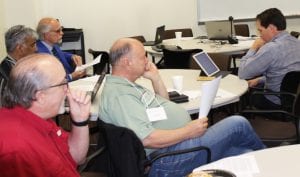Five Essentials of Job Skills Validation

The National Convergence Technology Center (CTC) recently hosted its National Business and Industry Leadership Team (BILT) for the annual job skills validation meeting. Regular blog readers know that this is one of the most important events of the year for the CTC and the 64 member colleges of the Convergence College Network (CCN). It’s at this meeting each May that IT employers gather together to update the job skills an entry-level IT worker will need to get hired in the next 18-24 months. The revised list – also referred to as the knowledge, skills, and abilities list, or just the “KSAs” – will eventually go out to the CCN for use at their local BILT meetings in the fall. The ultimate goal, of course, is to make sure the skills employers want are the skills students are actually being taught.
Here are five keys to a successful job skills meeting…
- Vote on the skill – Asking BILT members to vote on each skill one by one using a scale of 1 to 4 (4 being a skill that is very important) adds order and structure to the discussion. In other words, the voting spreadsheet – which is projected on a screen in the room so everyone can see it – creates a spine for the meeting and delivers an actionable, metric-driven document that faculty can reference later. Too often the CTC has reviewed job skills meeting minutes where there was no vote and found it challenging to fully understand just what the BILT was recommending.
- Conduct the meeting in real time – It can be tempting to ask BILT members to do their job skills ranking and voting asynchronously via email or an online survey. While you may get good data, it won’t be nearly as useful as the discussion that goes on in the room with everyone sitting together at the table. There is much value to be gleaned from those talks, especially the conversational sidebars and asides. Further, some schools attempt to gather feedback with surveys and email first and then discuss the results in person at the next meeting. The risk with this approach is that BILT members who voted online may feel they’ve done their part and choose not to attend the in-person meeting.

- Invite faculty – It’s important to have faculty in the meeting listening directly to the perspectives and recommendations of the BILT members. Remove the filter of meeting minutes. Let faculty hear it all for themselves. In addition, while the role of faculty at job skills meetings is to be an “active listener” and avoid unduly influencing the BILT, there are times when a question or topic arise that needs instructor feedback.
- The moderator doesn’t take notes – The person busy recording the votes and keeping track of the revisions and updates to each job skill on the spreadsheet can’t be the same person running the meeting. The moderator must stay at the front of the room focused on the big picture items: staying on time, steering the discussion, and keeping everyone involved, not just the ones with the loudest voice or biggest personality. It’s a full-time job.
- Crosswalk the skills back to curriculum – While this step doesn’t happen at the BILT meeting, without it the entire process is moot. Faculty need to take the recommendations of the BILT and do the work of making sure each skill is being taught in the classroom. If there are gaps, adjustments must be made, either by creating new classes or adjusting existing classes.
The CTC is developing a “BILT toolkit” to further train faculty and college administrators across the country how to successfully implement the BILT model. This toolkit will likely include video taken during this job skills meeting, including interviews with BILT members and CCN faculty. Look for updates in the coming months here on the CTC blog.
To learn more about the BILT model and the KSA process, watch the recent BILT Essentials webinar:
